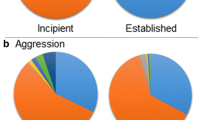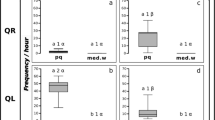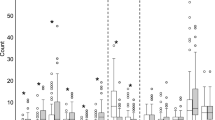Abstract
EVOLUTIONARY conflicts of interest are expected to arise in genetically diverse social groups1. In eusocial insect societies, a potential conflict exists between the queen and her workers over how active the workers should be2–5, and evidence exists that queen aggression increases activity levels of her lazier workers2,3. Here I provide evidence that queen aggression (shoving) in laboratory colonies of the eusocial mammal, the naked mole-rat (Heterocephalus glaber), is a convergently evolved manifestation of queen–worker conflict over worker activity. Queen-initiated shoves activate inherently lazy workers, which tend to be larger and/or less related to the queen than are infrequently shoved, industrious workers. In addition, queen removal selectively depresses the activity of workers that are larger and less related to her. Finally, queen shoving and worker inactivity are pronounced when colonies are satiated but not when colonies are hungry, indicating that the underlying 'work-conflict' is highly context-specific.
Similar content being viewed by others
References
Hamilton, W. D. J. theor. Biol. 7, 1–52 (1964).
Reeve, H. K. & Gamboa, G. J. Behav. Ecol. Sociobiol. 13, 63–74 (1983).
Reeve, H. K. & Gamboa, G. J. Behaviour 102, 147–167 (1987).
Schmid-Hempel, P. Am. Nat. 135, 501–526 (1990).
Reeve, H. K. & Sherman, P. W. in The Biology of the Naked Mole-rat (eds Sherman, P. W., Jarvis. J. U. M. & Alexander, R. D.) 337–357 (Princeton Univ, Press, Princeton, 1991).
Brett, R. A. in The Biology of the Naked Mole-rat (eds Sherman, P. W., Jarvis, J. U. M. & Alexander, R. D.) 97–184 (Princeton Univ. Press, Princeton, 1991).
Jarvis, J. U. M. Science 212, 571–573 (1981).
Jarvis, J. U. M. & Bennett, N. C. in The Biology of the Naked Mole-rat (eds Sherman, P. W., Jarvis, J. U. M. & Alexander, R. D.) 66–96 (Princeton Univ. Press, Princeton, 1991).
Reeve, H. K., Westneat, D. W., Noon, B. A., Sherman, P. W., & Aquadro, C. F. Proc. natn. Acad. Sci. U.S.A. 87, 2496–2500 (1990).
Lacey, E. A., Alexander, R. D., Braude, S. H., Sherman, P. W. & Jarvis, J. U. M. in The Biology of the Naked Mole-rat (eds Sherman, P. W., Jarvis, J. U. M. & Alexander, R. D.) 209–242 (Princeton Univ, Press, Princeton, 1991).
West-Eberhard, M. J. in Natural Selection and Social Behaviour (eds Alexander, R. D. & Tinkle, D. W.) 3–17 (Chiron, New York, 1981).
Jarvis, J. U. M. in The Biology of the Naked Mole-rat (eds Sherman, P. W., Jarvis, J. U. M. & Alexander, R. D.) 384–425 (Princeton Univ. Press. Princeton, 1991).
Braude, S. H. in The Biology of the Naked Mole-rat (eds Sherman, P. W., Jarvis, J. U. M. & Alexander, R. D.) 185–194 Princeton Univ. Press, Princeton, 1991).
Lacey, E. A. & Sherman, P. W. in The Biology of the Naked Mole-rat (eds Sherman, P. W., Jarvis, J. U. M. & Alexander, R. D.) 275–336 (Princeton Univ. Press, Princeton, 1991).
Reeve, H. K. thesis, Cornell Univ. (1991).
Author information
Authors and Affiliations
Rights and permissions
About this article
Cite this article
Reeve, H. Queen activation of lazy workers in colonies of the eusocial naked mole-rat. Nature 358, 147–149 (1992). https://doi.org/10.1038/358147a0
Received:
Accepted:
Issue Date:
DOI: https://doi.org/10.1038/358147a0
- Springer Nature Limited
This article is cited by
-
Punitiveness toward social distancing deviance in the COVID-19 pandemic: Findings from two national experiments
Journal of Experimental Criminology (2024)
-
The influence of social environment on cooperation and conflict in an incipiently social bee, Ceratina calcarata
Behavioral Ecology and Sociobiology (2021)
-
Independent evolution of pain insensitivity in African mole-rats: origins and mechanisms
Journal of Comparative Physiology A (2020)
-
Behavioural interference among eusocial naked mole rats during work
Journal of Ethology (2019)
-
Pushing Wasps to Work: Decentralized Aggression Induces Increased Activity in the Paper Wasp Polistes versicolor
Journal of Insect Behavior (2017)





